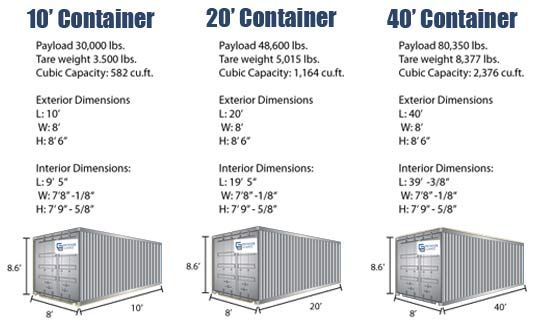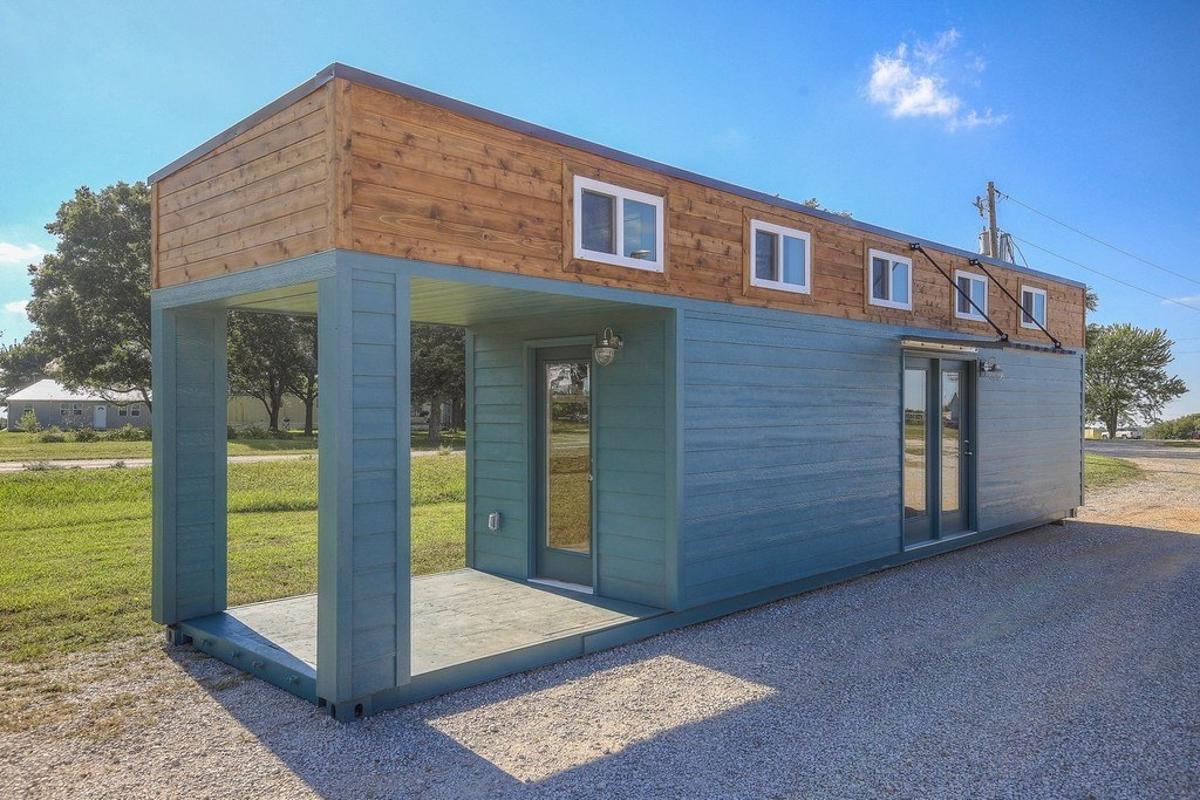This is Anthony Thompson, chief editor and the founder of this site, Tinyhousegarage. I'm a home architect. Basically, I've created this site to help people...Read more
What Is The Height Of A Container Home? If you’ve ever wondered about the dimensions of a container home, you’re in the right place! Container homes have been gaining popularity due to their unique and eco-friendly design.
These homes are made from repurposed shipping containers, but how tall are they exactly?
In this article, we’ll explore the height of container homes and provide you with all the information you need. So, let’s dive in and discover the incredible world of container home heights!
What is the height of a container home? – Key Takeaways
- Container homes typically have a height of about 8 feet, like a standard shipping container.
- Some container homes can be stacked to form multi-story structures.
- The height of a container home can be customized by removing the ceiling or adding extensions.
- It’s important to consider local building codes and regulations when determining the height of a container home.
- The height of a container home can impact its overall design and livable space.

What Is the Height of a Container Home?: A Comprehensive Guide
Understanding Container Home Height Requirements
Container homes have gained popularity in recent years as a sustainable and cost-effective housing solution. However, one consideration that often arises when planning to build or purchase a container home is the height restrictions. The height of a container home is an essential factor to ensure compliance with building codes and regulations. In this section, we will delve into the different height requirements for container homes and explore the factors that can affect the overall height of a container home.
Container Home Height Regulations
In most countries, building codes dictate the maximum allowable height for both residential and commercial structures. The height restrictions for container homes are generally similar to those for traditional homes. However, it’s crucial to consult local authorities and zoning regulations as they may vary depending on the area. Typical height restrictions for container homes range from 8 to 12 feet for each individual level or story. Some areas may have specific restrictions on the number of stories or the overall height of the structure, so be sure to research and seek guidance to comply with local regulations.
One important consideration is that the height restrictions for container homes are often measured from the ground level to the peak of the roof. If you plan to add features such as solar panels or rooftop gardens, they may need to be included in the overall height calculations. Additionally, keep in mind that the height restrictions may also apply to any outdoor structures, such as decks or patios, attached to the container home.
Factors Affecting Container Home Height
Several factors can impact the height of a container home beyond the constraints imposed by building codes. These factors include the type of foundation, roofing materials, and interior design choices. Let’s explore each of these factors in more detail:
- Type of Foundation: The foundation of a container home can influence its overall height. A traditional concrete foundation can add a few feet to the overall height, while a pier foundation or a raised deck-style foundation may offer flexibility in adjusting the height to meet local regulations.
- Roofing Materials: The choice of roofing materials can impact the height of a container home. Traditional asphalt shingles have a certain thickness that adds to the overall height. Alternatively, flat or low-profile roofing options, such as metal panels or a green roof, can help reduce the height while providing unique aesthetic and environmental benefits.
- Interior Design Choices: The layout and design choices within the container home can also affect its overall height. Incorporating loft spaces or mezzanines within the container can provide additional living areas without adding extra height. Clever storage solutions, like built-in cabinets or shelves, can maximize vertical space and make the most of the available height.
Benefits of Considering Container Home Height
When planning to build or purchase a container home, it’s essential to consider the height requirements for several reasons. Understanding the benefits associated with considering container home height can help you make informed decisions and avoid potential issues in the future.
Compliance with Building Codes
By adhering to the height requirements set by local building codes, you ensure the safety and structural integrity of your container home. Building codes are put in place to maintain a safe living environment and prevent any risks or hazards that may arise from non-compliance. Complying with these regulations will ensure a smooth approval process and minimize any potential complications that may arise during construction or when seeking permits.
Achieving Optimal Design and Functionality
Considering the height of a container home also allows you to optimize the design and functionality of the space. By carefully planning the height, you can create an interior layout that maximizes natural light, promotes efficient air circulation, and accommodates tall furniture or fixtures if desired. Additionally, being mindful of the height can help you make informed decisions when selecting roofing materials and other architectural features, allowing you to enhance energy efficiency and overall sustainability.
Creative Use of Vertical Space
Container homes often have limited square footage, but by utilizing the vertical space efficiently, you can create a comfortable and functional living environment. By considering the height, you can incorporate innovative storage solutions, loft spaces, or mezzanines, thus maximizing the available space and creating a unique and personalized living experience.
Choosing the Right Height for Your Container Home
When determining the height of your container home, it’s essential to consider your specific needs and preferences. While compliance with local regulations is paramount, you also have the opportunity to personalize your container home to suit your lifestyle. Here are some tips to help you choose the right height for your container home:
Evaluate Your Space Requirements
Assess your space requirements based on the number of occupants, desired room configurations, and any specific needs or preferences. Consider whether you need extra height for taller furniture, equipment, or fixtures, or if you can work within the standard height limitations to achieve your desired layout.
Consult with Professionals
To ensure compliance with local regulations and make informed decisions about the height of your container home, consult with professionals in architectural design, engineering, and construction. They can provide expert advice tailored to your specific circumstances and help you navigate any potential challenges or obstacles.
Consider Future Expansion
Think ahead and consider future expansion possibilities. If you anticipate the need for additional living or storage space in the future, you may want to factor that into the initial design and height considerations. By planning for potential growth, you can save time, effort, and costs associated with modifications or additions down the line.
Fire Safety Considerations for Container Homes
…
The Importance of Fire Safety in Container Homes
…
Fire Safety Measures for Container Homes
…
Weatherproofing Your Container Home: A Guide
…
Understanding the Importance of Weatherproofing
…
Key Weatherproofing Techniques for Container Homes
…
In summary, the height of a container home is an important consideration that affects compliance with building codes, design and functionality, and efficient use of vertical space. By understanding the height regulations, factors that influence height, and the benefits of considering height requirements, you can make informed decisions and create a container home that meets your needs and preferences. Consult with professionals and evaluate your space requirements to choose the right height for your container home. Additionally, considering fire safety measures and weatherproofing techniques are essential components of creating a safe and durable container home.
Frequently Asked Questions
What are the dimensions of a typical container home?
Container homes come in different sizes, but the most common ones are based on standard shipping container dimensions. These containers usually measure 8 feet in width, 8.5 feet in height, and either 20 or 40 feet in length. However, container homes can be customized to fit specific needs, and larger sizes may also be available.
What is the height of a standard container home?
The standard height of a container home is 8.5 feet. This allows for comfortable living space inside the container while still adhering to transportation regulations. The height may vary slightly in custom-made container homes, but it generally stays close to the standard size.
Can the height of a container home be increased?
Yes, the height of a container home can be increased by adding additional layers or extensions. This allows for more headroom or the inclusion of mezzanines or loft areas. However, it is essential to consult with professionals who have expertise in container home construction to ensure structural integrity and proper permits for any height modifications.
Are there any height restrictions for container homes?
The height restrictions for container homes can vary depending on local building regulations and zoning laws. Some areas may have restrictions on the maximum height allowed for residential structures, while others may have specific guidelines for container homes. It is important to check with the local authorities or consult with professionals experienced in container home construction to ensure compliance with height restrictions.
What are the benefits of having a higher container home?
Having a higher container home provides several benefits. It allows for more daylight to enter the space, creating a brighter and more spacious living environment. Additionally, a higher container home can accommodate taller furniture or appliances, offering greater flexibility in interior design. Finally, it may increase the resale value of the property, as it provides additional usable space and potentially more attractive aesthetics.
6 Types of Shipping Container Sizes for Building Homes
Summary
Container homes can vary in height, but most are around 8 feet tall. However, some container homes can be taller, measuring up to 9.5 or 10 feet. It’s important to consider the height when designing a container home to ensure it meets your needs.
When it comes to increasing the height of a container home, there are a few options. One is to join two containers together vertically, creating a double-height space. Another option is to use high-cube containers that are already taller than standard containers. Additionally, you can modify the roof to add extra height. Overall, the height of a container home can be customized to suit your preferences and requirements.

This is Anthony Thompson, chief editor and the founder of this site, Tinyhousegarage. I'm a home architect. Basically, I've created this site to help people build tiny houses with a limited budget and land space or people who are homeless. As a home architect, I became very disheartened when I saw homeless people around me, which influenced me to create this site to help people build beautiful tiny houses.
More Posts
